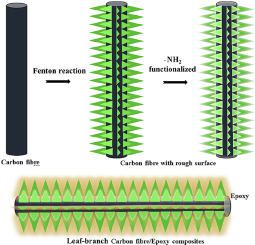当前位置:
X-MOL 学术
›
Compos. Sci. Technol.
›
论文详情
Our official English website, www.x-mol.net, welcomes your
feedback! (Note: you will need to create a separate account there.)
Improving the interfacial shear strength of carbon fibre and epoxy via mechanical interlocking effect
Composites Science and Technology ( IF 8.3 ) Pub Date : 2020-11-01 , DOI: 10.1016/j.compscitech.2020.108423 Hao Wang , Kai Jin , Jie Tao
Composites Science and Technology ( IF 8.3 ) Pub Date : 2020-11-01 , DOI: 10.1016/j.compscitech.2020.108423 Hao Wang , Kai Jin , Jie Tao

|
Abstract In this study, an effective and environmentally friendly method is proposed to enhance the interfacial shear strength between the carbon fibre and resin by the mechanical interlocking effect. The Fenton chemical reaction was used to oxidize and construct uneven structure on the carbon fibre surface, followed by functionalization with amine (-NH2) groups. The carbon fibre surface morphology was first designed, and the mechanical properties of the interface were investigated through molecular dynamics simulation. It was found that the interface shear strength increased by 277.9% and 133.6%, in comparison with the untreated CF and –NH2@CF, respectively. The microbond test showed that the interface shear strength improved by 251.1% and 159.4%, respectively, proving the effectiveness of our design within a certain error range. Moreover, the tensile strength increased by 8.39%. The proposed method opens up a new way to enhance the interface mechanical properties of fibre reinforced composite materials.
中文翻译:

通过机械互锁效应提高碳纤维和环氧树脂的界面剪切强度
摘要 在本研究中,提出了一种有效且环保的方法,通过机械互锁效应提高碳纤维与树脂之间的界面剪切强度。芬顿化学反应用于在碳纤维表面氧化和构建不均匀结构,然后用胺(-NH2)基团进行功能化。首先设计了碳纤维表面形貌,并通过分子动力学模拟研究了界面的力学性能。结果表明,与未处理的 CF 和 –NH2@CF 相比,界面剪切强度分别增加了 277.9% 和 133.6%。微键测试表明界面剪切强度分别提高了251.1%和159.4%,证明了我们设计在一定误差范围内的有效性。而且,抗拉强度提高了8.39%。该方法为增强纤维增强复合材料的界面力学性能开辟了一条新途径。
更新日期:2020-11-01
中文翻译:

通过机械互锁效应提高碳纤维和环氧树脂的界面剪切强度
摘要 在本研究中,提出了一种有效且环保的方法,通过机械互锁效应提高碳纤维与树脂之间的界面剪切强度。芬顿化学反应用于在碳纤维表面氧化和构建不均匀结构,然后用胺(-NH2)基团进行功能化。首先设计了碳纤维表面形貌,并通过分子动力学模拟研究了界面的力学性能。结果表明,与未处理的 CF 和 –NH2@CF 相比,界面剪切强度分别增加了 277.9% 和 133.6%。微键测试表明界面剪切强度分别提高了251.1%和159.4%,证明了我们设计在一定误差范围内的有效性。而且,抗拉强度提高了8.39%。该方法为增强纤维增强复合材料的界面力学性能开辟了一条新途径。











































 京公网安备 11010802027423号
京公网安备 11010802027423号